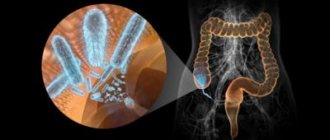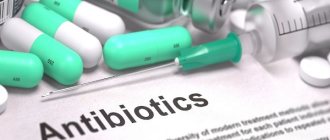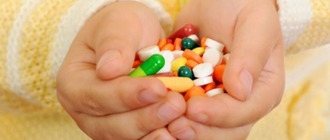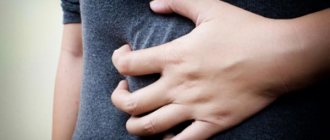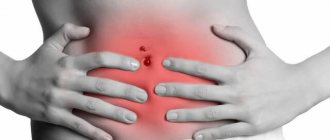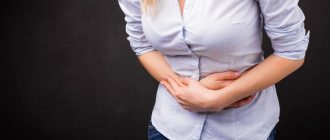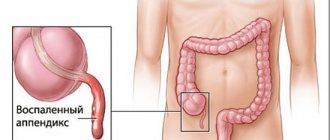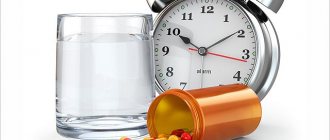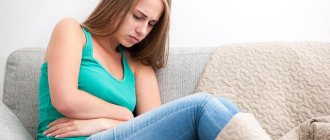Can antibiotics cause pain?
Antibacterial agents are created to combat pathogenic microflora in various infectious diseases. When taking these medications, not only prokaryotic cells die, but also healthy lacto- and bifidobacteria in the stomach and intestines.
The gastrointestinal tract contains beneficial microorganisms that help healthy digestion.
The state of human immunity largely depends on them .
After long-term use of antibiotics, not only pathogenic bacteria die, but also the native intestinal microflora is disrupted. During this period, a person may experience malaise, dyspeptic disorders, and abdominal pain.
Various forms of release of antibacterial agents, dosage, frequency of administration equally negatively affect the digestive organs, especially the stomach and intestines. Pain and diarrhea appear after injections and tablets.
Negative consequences can occur while taking the drug, immediately after its discontinuation, and even a month after treatment.
Diet while taking antibiotics
An important aspect of antibiotic treatment is the drinking regime and food menu. Few people know, but you need to take an antibacterial tablet with 200-250 ml of water. In this case, be sure to follow the instructions for taking the drug, most often 2 hours before or after meals.
A properly formulated diet is part of the therapy that will be required for effective and faster treatment.
By including dairy products in your daily menu, which are rich in live cultures of lacto- and bifidobacteria, you can not only support your body during illness, but also improve intestinal motility.
Causes of pain
As a result of taking antibiotics, a bacterial imbalance (dysbacteriosis) occurs in the intestines.
Antibacterial drugs reach the mucous membrane of the stomach and then the intestines, affecting not only pathogenic bacteria, but also beneficial microflora, as a result of which unbearable pain occurs in the abdominal area, the mucous membrane of the stomach and intestines becomes inflamed, diarrhea, vomiting, and flatulence may begin.
Comparative table of action and composition of pro- and prebiotics
| Properties | Prebiotic | Probiotic |
| Action | stimulation of the growth of natural intestinal microflora | colonization of the intestine with microflora from the outside |
| Compound | substances that provide food for beneficial bacteria found in the intestines | living cells of beneficial intestinal microflora: dactobacilli, bifidobacteria, etc. |
| Passage through the digestive organs | one of the main properties of prebiotics is that they are not digested and reach the intestines in their entirety with unchanged properties | approximately 5-10% of probiotics taken can reach the intestines in their original form |
| Efficiency | taking prebiotics stimulates an increase in the population of bacteria beneficial to the body | There are about 500 types of beneficial bacteria in the intestines; a probiotic can contain no more than 1-2 types |
How to understand that antibiotics provoked pain
If the disease was treated with antibiotics, and pain began during or a few days after, intestinal upset is associated with taking these medications.
If probiotics are not treated in conjunction with antibacterial therapy, dysbacteriosis is 100% likely to develop and accompanying symptoms appear.
Before starting treatment, you must study the instructions for the drug. It usually lists abdominal pain as one of the side effects.
If all these symptoms appear after using antibiotics, a diagnosis of dysbacteriosis is made. This pathology is also accompanied by stomach pain.
Treatment methods
If spasms and pain appear after taking antibacterial drugs, probiotics, antispasmodics, and antidiarrheals are prescribed.
Medicines to restore microflora
First of all, the following drugs are prescribed to stop diarrhea in case of gastric dysbiosis (abdominal pain is one of its symptoms): Enterol, Enterosgel, Smecta.
To restore disturbed intestinal microflora, probiotics and prebiotics are prescribed.
This group of drugs includes Hilak, Bifiform, Acipol:
- Hilak is a drug that normalizes intestinal flora. It affects the digestive system and metabolism. With the help of these drops, diarrhea is stopped, inflammation of the stomach and intestinal mucosa is relieved. The drug stimulates the growth of the epithelium of the intestinal wall, restoring its integrity.
- Bifiform is a drug that normalizes intestinal flora during antibiotic therapy. Contains lactic acid bacteria that can restore intestinal microflora.
- Acipol is used for dysbacteriosis, including after antibiotic therapy. Contains lactobacilli, kefir fungus, which is able to restore intestinal microflora.
To relieve stomach cramps, the doctor may prescribe special drugs Mebeverine, Dicetel.
Folk remedies
To avoid stomach pain, you should drink warm chamomile tea. 1 tbsp. l. dry chamomile flowers are poured with a glass of boiling water and left for half an hour.
Once the tea has cooled to a comfortable temperature, you can drink it 30 minutes before meals.
In this recipe, chamomile acts as a natural antispasmodic.
Calendula tincture is also good for relieving stomach cramps. It is sold in every pharmacy and is inexpensive. 1 tbsp. l. tinctures are diluted in half a glass of warm water, take the solution three times a day an hour before meals.
It is important that the tea must be made fresh every time.
To soothe an irritated stomach, relieve inflammation of the mucous membrane, and restore microflora, traditional medicine recommends consuming fermented milk products:
- kefir;
- fermented baked milk;
- yogurt;
- fermented milk whey;
- curdled milk;
- acidophilus.
Drink them in the morning on an empty stomach and in the evening before bed. These products contain lactic acid bacteria .
With regular consumption, the intestinal microflora will be restored, your health will improve after taking antibiotics, your digestion will improve, and cramps and stomach pain will go away.
Diet and nutrition for recovery
During antibiotic treatment, it is good to include fermented milk products, sauerkraut, fruits, vegetables, and berries in the patient’s diet. They are also called natural probiotics.
Contain a small amount of probiotics and help maintain healthy intestinal microflora:
It is good to eat foods rich in fiber during the treatment period - beets, fresh and sauerkraut, broccoli, lentils, and nuts. They cleanse the intestines well, and the nutrients contained in them are absorbed almost completely.
During the period of antibacterial therapy, vitamin deficiency develops in adults and especially in children. It is recommended to support the body at this time and start taking vitamin complexes after a course of antibiotics.
You cannot combine antibacterial drugs and grapefruit and orange juices. They neutralize the effect of drugs, and treatment may not be effective.
Also exclude all heavy and harmful foods from the diet:
- everything fried and fatty;
- sausages;
- marinades;
- confectionery and bakery products.
Reason: they put additional stress on the liver and digestive system, which becomes vulnerable when taking medications.
It is important to drink at least 2-3 liters of water per day during the treatment period . Almost all medications are eliminated through the kidneys, and water allows you to speed up this process and cleanse the body.
List of medications that support intestinal microflora when taking antibiotics
Eating such food is guaranteed to reduce irritation on the mucous membranes of all organs of the gastrointestinal tract. Such dishes can be soups, cereals, boiled vegetables, and jelly.
- If you want to protect your stomach from antibiotics, it is not recommended to take antibiotic medications with tea, juices and coffee. Using ordinary boiled water for these purposes is more appropriate and does much less harm.
- Also, stomach protection can be achieved by parallel intake of modern medicines with antibiotic drugs, which very effectively restore the intestinal microflora, as well as the entire gastrointestinal tract, and doctors also recommend taking vitamin complexes while taking antibiotics.
- Significantly reduces the load on the digestive system by taking antibiotics by intramuscular or intravenous administration. Another advantage of this method of treatment is that this use of an antibiotic has a more effective effect on the underlying disease.
- Among other things, infusions of mint, lemon balm, chamomile and other medicinal herbs are an excellent assistant for the patient in restoring the microflora of the digestive system.
Which organs can be affected by antibiotics?
When taking penicillin antibiotics, an allergic reaction may develop, swelling and severe pain in the throat.
Drug fever develops when taking beta-lactam antibiotics.
Its first symptoms are chills, aching joints and bones .
Some antibiotics cause kidney toxicity. While taking them, you may feel pain in the lumbar region.
During treatment, women develop vaginal dysbiosis, which is accompanied by pain in the lower abdomen.
Almost all antibacterial therapy drugs negatively affect the liver, stomach, and intestines, so pain in the right or left hypochondrium, in the iliac region, in the lower abdomen appears while taking antibiotics.
How to restore the stomach after antibiotics
The effect of antibiotics on the body
Indeed, along with harmful microorganisms, bacteria that are directly involved in digestion also come under attack:
After antibiotics, it is necessary to carry out a course of restorative therapy, especially if these drugs were taken for a long time.
In addition, it is necessary to protect the stomach while taking medications. Only then can the harm from drugs be minimized.
How to protect your stomach
- Never take medications on an empty stomach . Antibiotics can be taken only 20 minutes after meals. But overeating in this case is also not recommended.
- Include enveloping dishes in your menu . These include various soups, cereals, pureed vegetables, and jelly.
- During the course of treatment, avoid eating fatty, salty and spicy foods . At this moment, your stomach is especially vulnerable, and such food will not do it any good.
- Water is the best liquid for “washing down” tablets . You should not use tea or juice for these purposes. And you should also not take medications with carbonated water, even mineral water.
- Alcohol and antibiotics do not mix well with each other, so completely avoid strong drinks during therapy.
- If possible, replace tablets with intravenous or intramuscular injections. This way, the antibiotics will go directly into the blood without causing enormous harm to the stomach.
- Take probiotic products that protect microflora and prevent the development of dysbiosis.
If you follow these rules, you can avoid many unpleasant phenomena. But after a course of antibiotic treatment, it is important to carry out restorative therapy. This is especially important after long-term use of such drugs.
How to restore the stomach after a course of antibiotics
To get rid of dysbiosis, you need an integrated approach, including:
In addition, it is important to carry out a cleansing diet that lasts at least three months.
Diet for dysbacteriosis
At this time, foods that cause “fermentation” and create favorable flora for various pathogens should be excluded.
- sugar;
- confectionery;
- yeast baked goods.
During this period, you should also not overuse fresh milk and potatoes. It is better to keep the intake of these products to a minimum.
How long does it take for antibiotics to leave the body?
But the question remains how long it takes for antibiotics to be eliminated from the body. Most drugs in this group are excreted in the urine. The time period depends on many factors, for example, the form of release, the chemical composition, and the age of the patient. The average is 8 hours after the last dose, the maximum is 7 days, but after two days the number of units of the drug in the urine becomes minimal.
Another popular question is whether there is a faster way to remove antibiotics from the body after treatment. In order to get rid of toxic decay and drug residues, it is necessary to drink a large amount of liquid; it is also recommended to include fermented milk products in the diet, which help remove toxic substances from tissues.
Source
Treatment of stomach pain after antibiotics
The invention of antibiotics helped save the lives of millions of people. Even according to the most conservative estimates, bacterial diseases have claimed more lives than all existing wars.
Let's consider the causes of discomfort, ways to eliminate and prevent it, and other features.
Causes of pain
The structure of the human body is such that various types of bacteria, both harmful and beneficial, live in our body on a permanent basis. If a person is healthy, a state of equilibrium is observed between these groups of microorganisms, when conditionally harmful bacteria are restrained by beneficial ones, and at the same time, the existence of both types of microorganisms has a positive effect on the functioning of internal organs. This condition is called the microflora of the body, for example, intestinal microflora.
Thus, after taking antibiotics, the function of the stomach is disrupted, diarrhea, colic and other stomach pain appear.
When to see a doctor and how to know if an antibiotic is not suitable?
- after 3 days of taking the drug, the condition only worsened, the temperature or remained at the same level;
- allergic reactions are noticeable during treatment;
- severe side effects from the gastrointestinal tract (stomach pain, diarrhea, flatulence, colic, vomiting);
- damage to liver and kidney tissue;
- other side effects.
Most often, you can find a suitable drug on the second try, but there are exceptions when you have to try several different antibiotics for the treatment to produce results.
You should consult a doctor to receive a prescription for antibiotics in the following cases:
Treatment
Below, we will present several treatment options for stomach pain after antibiotics.
Medications
- Immunal, as well as analogues of this drug, basically contain extracts of echinacea and ginseng. The cost of the drug in tablets (20 pcs.) or drops is 300 - 350 rubles.
- Imudon is a drug of bacterial origin. Stimulates phagocytosis, provoking the growth of immune cells. The cost of the drug in the form of tablets (24 pieces) is 440 rubles.
- Acyclovir is a medicine containing nucleic acids. Its main function is to increase the body’s resistance at a general level. The cost of 20 tablets, 200 mg each is 70 rubles.
Multivitamins contain a whole range of useful microelements that are so necessary for the body. While taking antibiotics, the body experienced a noticeable lack of essential microelements, so the reserve must be restored.
Please note that there is no vitamin complex that contains the entire list of microelements. This is not possible due to their partial incompatibility.
- Vitrum #8212; one of the most popular vitamin manufacturers. The cost of 50 tablets is 530 rubles.
- Alphabet Classic is a domestically produced drug that has become popular due to its favorable price/quality ratio. The cost of a package of 120 tablets is only 370 rubles.
- Gerimaks #8212; tablets from Denmark. The cost of a package (30 tablets) is 470 rubles.
How to restore the stomach after antibiotics
The effect of antibiotics on the body
Indeed, along with harmful microorganisms, bacteria that are directly involved in digestion also come under attack:
After antibiotics, it is necessary to carry out a course of restorative therapy, especially if these drugs were taken for a long time.
In addition, it is necessary to protect the stomach while taking medications. Only then can the harm from drugs be minimized.
How to protect your stomach
- Never take medications on an empty stomach . Antibiotics can be taken only 20 minutes after meals. But overeating in this case is also not recommended.
- Include enveloping dishes in your menu . These include various soups, cereals, pureed vegetables, and jelly.
- During the course of treatment, avoid eating fatty, salty and spicy foods . At this moment, your stomach is especially vulnerable, and such food will not do it any good.
- Water is the best liquid for “washing down” tablets . You should not use tea or juice for these purposes. And you should also not take medications with carbonated water, even mineral water.
- Alcohol and antibiotics do not mix well with each other, so completely avoid strong drinks during therapy.
- If possible, replace tablets with intravenous or intramuscular injections. This way, the antibiotics will go directly into the blood without causing enormous harm to the stomach.
- Take probiotic products that protect microflora and prevent the development of dysbiosis.
If you follow these rules, you can avoid many unpleasant phenomena. But after a course of antibiotic treatment, it is important to carry out restorative therapy. This is especially important after long-term use of such drugs.
How to restore the stomach after a course of antibiotics
To get rid of dysbiosis, you need an integrated approach, including:
In addition, it is important to carry out a cleansing diet that lasts at least three months.
Diet for dysbacteriosis
At this time, foods that cause “fermentation” and create favorable flora for various pathogens should be excluded.
- sugar;
- confectionery;
- yeast baked goods.
During this period, you should also not overuse fresh milk and potatoes. It is better to keep the intake of these products to a minimum.
Many people have encountered a protracted, serious illness that cannot be cured without taking antibacterial agents. The action of antibiotics is aimed at eliminating or stopping the proliferation of pathogens. Due to its wide spectrum of action, the medicine not only rids the body of pathogens, but also kills beneficial bacteria. The entire gastrointestinal tract suffers from this, and dysbiosis develops. Therefore, it is not surprising that your stomach hurts after antibiotics.
Why does dysbiosis occur after taking antibiotics?
During antibiotic therapy, pathogenic microflora is destroyed and the activity of beneficial bacteria is inhibited.
Antibiotics disrupt the natural intestinal balance, reduce the body's resistance and local immunity. In adults, intestinal dysbiosis occurs in the form of a minor stool disorder; after completing the course, the microflora is restored along with digestion. In children, dysbiosis is more pronounced and more complex, and corrective therapy is often required.
The occurrence of dysbiosis with antibiotic therapy is influenced by the duration of the treatment course and the type of antibiotic. Thus, the likelihood of developing drug-induced dysbiosis with a course of more than 7-10 days is much higher than with antibiotic therapy for a course of 5 days.
Effect on the gastrointestinal tract
The effect of antibiotics is aimed only at pathogenic microorganisms , but their spectrum of action also covers the entire beneficial intestinal microflora.
Taking certain types of antibiotics is especially important:
- cephalosporins - provoke the development of dysbiosis 3-5 days after the start of the course, the disease is accompanied by diarrhea;
- tetracyclines - help destroy beneficial microorganisms in the upper intestines, increase the load on the membranes of the tract;
- fungicides - while taking it, the reproduction and development of beneficial microflora is impossible;
- aminoglycosides and amoxicillins - cause dysbiosis in children after 5 days of administration, in adults - after 7-10 days or do not cause at all;
- penicillins - after a course of treatment, they create conditions for the growth and activation of opportunistic microflora.
Long and frequent courses of antibiotic therapy increase the risk of dysbiosis . Thus, the development of intestinal dysbiosis in adults can be hidden, symptoms do not appear or occur after 7-10 days. Immediately after finishing the intake, the intestinal microflora is restored.
Note! Children develop diarrhea on days 5-7 of therapy; streaks of blood and particles of undigested food are present in the stool. Young children require special treatment.
What causes abdominal pain
The gastrointestinal tract works as follows: in the stomach after eating food, it is broken down through the juice it produces and continues on its way to the intestines, where it is absorbed. Antibiotics are mixed in the body along the same path, but begin to be absorbed at the first stage, so they must be consumed only after a person has eaten. This avoids stomach pain.
Stomach upset after taking antibiotics is common. After all, it is necessary to take probiotics along with such medications. If the latter are not drunk, the medicine kills the microflora, which is expressed as dysbacteriosis. Associated symptoms will be: heaviness and pain in the stomach, nausea.
What should you do if you need to take antibiotics because there is no other way to cure the disease? Follow a number of recommendations:
- Be sure to eat before taking your medicine, but do not overeat.
- When taking the drug, eat foods that can coat the gastric organ: puree soup, jelly, slimy porridge. The following are harmful to the stomach when treated with antibiotics: coffee, tea, marinade, spicy dishes, alcoholic drinks.
- It is better not to take medications in tablet form. Intramuscular or intravenous administration is much safer for microflora. The medicine immediately enters the bloodstream, bypassing the gastrointestinal tract, causing virtually no side effects.
- Take your medications with only half a glass of filtered water. Juices, milk, tea, etc. are not suitable.
- The antibiotic also kills beneficial bacteria, so you also need to take probiotics at the same time so that the microflora returns to normal.
Does the body suffer greatly when treated with such drugs? Ask your doctor if you can replace it so as not to harm your health so much.
Bacterial complexes for microflora
To treat dysbiosis after antibiotic therapy, the following drugs and complexes are most often prescribed :
- "Acipol" . The drug reduces the symptoms of dysbiosis, improves peristalsis, and helps restore intestinal microflora. The main indication is a long therapeutic course, as well as other intestinal pathologies, infections, intoxications of any nature.
- "Linex" . The drug contains live bacteria that make up the healthy intestinal microflora of children and adults. Available in capsules, the course of treatment is long, more than a month, one capsule per day. During this time, it is possible to completely restore intestinal functions and remove the remaining antibiotics.
- "Bifidumbacterin" . The best antagonist against pathogens and drugs. The product not only restores microflora, but also improves immunity. It has virtually no contraindications or side effects. Today this is one of the best and inexpensive means for treating dysbiosis.
- "Hilak forte" . A drug for treating symptoms of dysbiosis, creating a favorable environment for the growth and reproduction of beneficial bacteria. The main indications are pain in the stomach, dysbiosis, including drug-induced, infections.
- "Lactobacterin" powder. The drug is prescribed immediately after completion of the course, duration of administration is 7-10 days. Before use, the powder is diluted with water and drunk immediately.
- "Biovestin" and "Biovestin-Lacto" . They contain high concentrations of bifidobacteria, living bacteria that fill the intestines and have a beneficial effect on its functions.
What to drink along with antibiotics for dysbiosis? Drugs for symptomatic therapy can enhance the effect of bacterial complexes . The following medications are considered the most effective:
- "Smecta" . It perfectly relieves diarrhea against the background of medicinal dysbiosis; the best effectiveness is achieved with the use of other drugs against dysbiosis. Does not contain beneficial bacteria, but creates favorable conditions for the formation of new colonies.
- "Artromax" . A herbal preparation that allows you to create favorable conditions for the growth and development of beneficial microflora. Goes well with bacterial complexes. A beneficial effect can only be achieved in combination. The main indications for use are dysbacteriosis of any nature, dysfunction of the gastrointestinal tract.
If unpleasant symptoms occur, antispasmodics , antacids, and absorbents are indicated for the rapid removal of toxins and metabolic products.
How to take antibiotics correctly
Antibiotic treatment disrupts digestion. What should you do and what rules should you follow when taking medications in order to maintain normal well-being in your stomach? Take your medications correctly:
- Some people say: I take the analogue, it’s cheaper, but the effect is the same. You should not do this if the doctor has prescribed it, you must adhere to his recommendations.
- The antibiotics you take are stored in the refrigerator.
- People often ignore medical advice, saying: I take medications when I have a free minute. Diseases should be treated with an antibiotic strictly according to the allotted time and duration of administration prescribed by the attending physician.
- Read the instructions for the medicine carefully. If she requires you to take pills before meals, take them that way. When instructed to store in a dark place, do not disregard the advice.
- Does your stomach hurt after antibiotics? Perhaps the person washed the product down with milk, which led to a similar reaction. Tetracycline behaves exactly like this in such a situation. Remember that you can only drink water.
- Before prescribing a medicine, the doctor is obliged to ask the patient whether he was treated with antibacterial agents and for how long.
Following the above recommendations will facilitate the restoration of microflora after antibiotics. In some cases, stomach treatment may not be necessary.
How to improve your gastrointestinal tract after antibiotic treatment
What to drink to restore beneficial bacteria in the body? A gastroenterologist will definitely answer this question. It is worth turning to him if the microflora is disturbed after treatment with antibiotics. The patient needs to improve his lifestyle, give up bad habits and act according to the doctor’s recommendations.
The patient should know that tobacco smoke negatively affects the condition of the gastric mucosa; alcohol does not allow the organ to recover fully, delaying recovery. The liver suffers the most, thereby failing to cope with the function of cleansing the body of toxins. Exercising has a good effect on raising and strengthening the immune system.
Proper nutrition
How to restore the stomach after antibiotics? The best assistant in this is a healthy diet. After all, diet first of all helps to improve the digestive functions of the body, which helps to improve the well-being of a person as a whole. Doctors advise:
- Avoid eating fried and smoked foods until better times. There are only dietary products.
- For constipation, give preference to prunes, beets, oatmeal and fresh fruits.
- Eat boiled zucchini, cauliflower, carrots and baked apples as often as possible.
- Reduce your consumption of baked goods, legumes and pears to a minimum.
- Bone broth rich in glutamine restores liver function.
Such food can be diluted with fermented milk drinks, which are useful for restoring the microflora of the gastrointestinal tract. It is useful to drink them before going to bed.
Dried chamomile helps with cramps. Take the decoction up to 5 times a day. Also apply heat. It can relax muscles and alleviate pain. Ginger tea has the same effect. Drink it 0.5 glasses three times a day. For diarrhea, drink a decoction of rice, which coats the walls of the stomach and relieves irritation of the mucous membrane.
Reception frequency
When answering the question of how often you can take antibiotics, it is worth noting that each of them has its own frequency of administration.
Sometimes this is only once a day, while some drugs can be taken several times more often. The frequency depends on the time during which the medicine exists in the body and has a positive effect on it. For example, a three-time dose is prescribed if the antibiotic is effective for 8 hours, after which it is eliminated through the liver or kidneys. By the way, this is exactly the eight-hour interval that should exist between taking the medicine. If for some reason the patient did not have time to take the antibiotic in a timely manner, for example, before breakfast, and the time is already moving toward lunch, the dosage should not be doubled. Indeed, in this case, the effect of the drug will not double - the body will simply receive an increased portion of the drug and may not be able to cope with such an amount. Due to the toxic effect of antibiotics, bacteria may die, but various internal organs may be damaged, and health will deteriorate. Moreover, after some time the disease will subside, and side effects from exceeding the dosage will have to be treated for a long time.
An unpleasant consequence of reducing the dose (if the patient decides, for example, to completely skip taking the medicine) is the same increase in the resistance of the infection to the drug, which also occurs if the duration of the course of treatment is violated. But bacteria that have become immune to the drug will be much more difficult to deal with.
Drug treatment of the digestive organ
Special medications will help restore the stomach after antibiotics. It is important to remember that any medication is prescribed exclusively by a specialist individually to each patient.
Enzyme-containing products
The tablets accelerate processes that restore the functioning of the stomach and intestines. Doctors often prescribe Mezim, Pancreatin, Duphalac for people treated with antibacterial drugs.
Prebitotics, probiotics
After antibiotics, how to restore microflora? Prebiotic and probiotic medications will help with this. The former contribute to the formation in the stomach of such important microorganisms as lacto- and bifidobacteria, which are able to improve the functioning of the digestive system. The most popular of them: Hilak-Forte, Duphalac, Ambien. Probiotics support the functioning of the stomach. An adult is prescribed Ailakt, Linex, Bifi-form.
When treated with antibiotics, a lot of beneficial bacteria are destroyed, the restoration of which takes a long time. Probiotics help with this.
Alternative medicine will help solve the problem
What to take for dysbacteriosis? Grandma’s recipes, which quickly eliminate the signs of the disease, will help solve the problem. The following remedies will help eliminate the problem of lack of bacterial norm:
- Take 10 grams of walnuts, pumpkin, sunflower and chop everything. Pour 100 grams of boiling water and leave for a while. Carry out treatment for 10 days, taking after sleep and before going to bed.
- Currants and raspberries cope well with diarrhea. Drink berry compote to improve your overall well-being, 2-3 glasses per day.
- To restore, they also drink dill water. Pour 100 grams of boiled water over a teaspoon of seeds. Filter and drink one spoon three times a day. The product easily copes with flatulence.
- People who take antibacterial medicine for a long time have to take beetroot juice to normalize the number of red blood cells.
- A critical condition that disrupts the functioning of the stomach due to the use of antibiotics is improved by an infusion of kombucha.
Propolis is considered a natural antibiotic that can restore the functioning of the stomach in the shortest possible time.
Helpful tips when taking antibacterial medications
In addition, if you want to take prebiotics and probiotics with antibiotics, you need to do the following at home:
- Do not take medications of this pharmacological group because they helped someone. Always consult your doctor.
- After taking antibacterial agents, my stomach hurts, but the course is not over yet. The doctor will change the drug and select a more suitable one to eliminate the complication.
- Self-medication with antibiotics and painkillers at the same time is prohibited. Strengthening the effect can lead to irreversible consequences.
- Antibiotics do not work against viruses. They only treat bacterial infections.
What drugs will relieve abdominal pain after antibacterial drugs. Prebiotics and probiotics, as well as some traditional medicines, have these properties.
After taking antibiotics, the stomach hurts due to the lack of beneficial bacteria, which the drug kills. The microflora can be restored through various actions recommended by a specialist. Otherwise, if untreated, harmful bacteria will poison the liver and the body, respectively, which will lead to severe irreversible consequences.
Duration of treatment
As a rule, the duration of the course of treatment prescribed by the doctor is from 7 to 10 days. Sometimes, when using a number of special drugs, the period of use can be no more than 6 days. However, whatever the appointed time, it must be observed very strictly. While some patients, immediately after their health improves, independently reduce the dose of the antibiotic and even stop taking it completely. Such actions can lead to undesirable consequences:
Some antibiotics have a long-lasting effect, due to which they can be taken for only 3 days. Among them is sumamed, used as a medicine for sore throats. However, there is another option when the period of taking the drug does not exceed 3 days - for example, if it turns out to be unable to cope with bacteria during this period, and the patient’s well-being does not improve. In this case, the attending physician will prescribe a different antibiotic.

